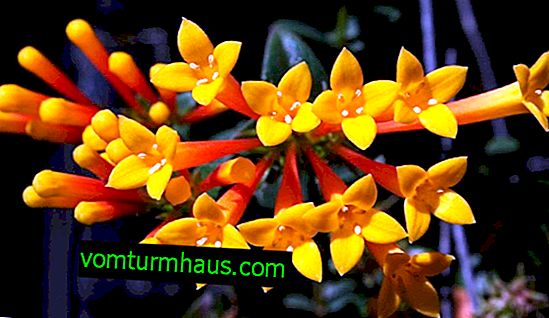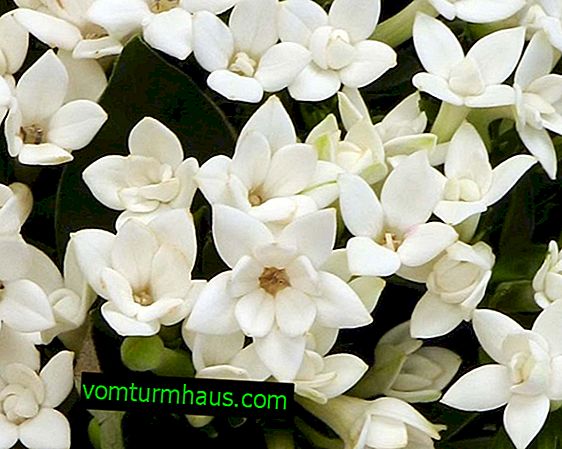Bouvardia: description of the plant, cultivation and care at home
Bouvardia - beautiful flowering evergreen herbs that are found in the wild tropical and subtropical forests of Central America and Mexico. In our latitudes it is grown as a home plant, in summer it feels great in the open ground. It is used for flower arrangements, landscaping of residential and office premises. We suggest considering the features of care and breeding of bouvardia at home.
Houseplant Description
General characteristics of the plant:
- the bouvardia belongs to the Marenova family, which includes several subspecies;
- the root system is superficial, small-sized;
- depending on the species, the height of the plants varies between 50-150 cm;
- stems are straight, slightly branched;
- leaves of a rounded or elongated shape with pointed ends, 3-10 cm long are opposite or form whorls;
- the structure of the leaves is dense, the outside is dark green, the inside is 2 tones lighter;
- the bouvardia enters the flowering phase in May and leaves it in September-October;
- flower buds collected in scutes up to 15 cm in diameter are formed on the tops of young shoots;
- the color of the tubular flowers is pink or white;
- each flower consists of 4 petals bent down.
Important! The most magnificent flowering of the bouvardia is observed in the second year of life, so at home it is cultivated as a two-year-old plant, and then updated.
The most common varieties cultivated at home:
- bouvardia home;

- yellow;

- long-flowered;

- jasmine-flowered.

Optimal conditions
Plants are undemanding in care.
The main task is to maintain optimal indoor climate:
- lighting - bright, scattered, within 3, 000–3, 900 lux;
- temperature in summer - +20 ... + 25 ° С;
- temperature in winter - +10 ... + 12 ° С;
- air humidity - moderate - 40-60%;
- soil moisture - moderate - 40-50%.
















Home Care
Growing bouvardia at home, you need to pick up shallow wide ceramic pots with a large number of drainage holes. It is better to place flowers on the southeast window sills.
Did you know? An interesting design decision in eco-style is a table in which the countertop consists of several tiers, including niches for planting grass, succulents, cacti and even dwarf trees. The top of the countertop is made of durable clear glass. This piece of furniture has a rather large work surface and allows you to contemplate your own mini-garden at the same time, which has a beneficial effect on the mental state of people.
Watering and feeding
Bouvardia is irrigated when the topsoil dries to a depth of 2-3 cm. Use soft water without chlorine impurities at room temperature. The leaves should be periodically wiped with a wet swab to remove dust. Fertilizers begin to be applied from March every 2 weeks until the very end of flowering. In winter, fertilizers are not applied.
As fertilizer, combined mineral compositions with a minimum nitrogen content are used. Potassium monophosphate is ideal in this regard. In mid-summer, you can feed the plants with dolomite flour - 5 g of substance per plant. Dolomite flour can be replaced with crushed, pre-fried egg shells.

Pruning
To form a lush bush in the first year of plant life, you need to pinch the young shoots halfway. Subsequently, pruning is carried out in spring and autumn, cutting off 70% of old shoots.
Transfer
One-year-old plants are transplanted when the old pot has become cramped. They are manipulated in the spring before the start of active growth, in March-April. For bouvardia, you need to prepare drained loose soil. Universal soil mixed with perlite and sand in a ratio of 1: 0.5: 0.5 is ideal.
Brick chips are placed at the bottom of the pot, followed by a layer of sand. 2-3 hours before transplanting, the flower is watered, and then transferred to a new container. The voids are filled with nutritious soil, lightly tamped next to the main stem and moistened with a spray bottle.
Find out how and when to transplant indoor plants.
Breeding methods
Bouvardia is propagated in 2 ways:
- cuttings;
- dividing the bush.

Features of care during the flowering period
Flowering bouvardia, depending on the variety, occurs in May or June. The flowering period lasts 4-5 months. In some varieties, flowering occurs in winter, for example, in the bouvardia jasmine-flowered. Shields that have already faded must be removed immediately. During the flowering period, the intensity of irrigation is increased, carrying it out every day from the spray gun. Do this carefully so that moisture does not get on the leaves.
Important! If the flowering takes place in winter, top dressing must be applied once every 2 weeks. In the cold season, liquid mullein can be used as fertilizer, alternating it with potassium monophosphate and dolomite flour.
Possible growing problems
When growing bouvardia at home, plant breeders may encounter the following problems:
- Root rot - caused by stagnation of water in the tank. The disease is not treated. Before being disposed of, the plants are divided into cuttings if this rot has not yet spread throughout the stem.
- Chlorosis of foliage - caused by irrigation with poor-quality water. For prophylaxis, iron chelate is supplemented.








